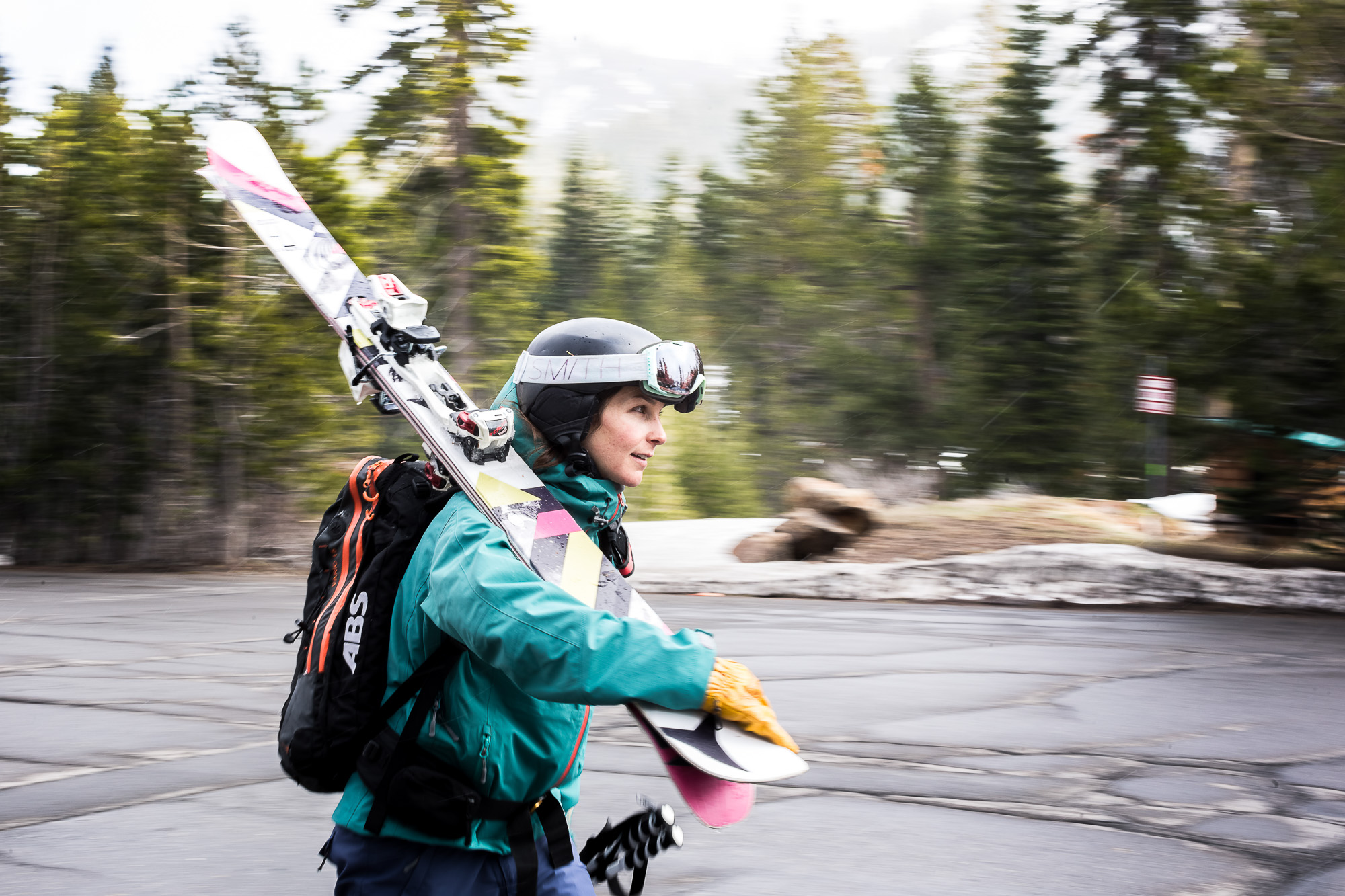Outdoor sports exist and thrive within their own vibrant communities and cultures, often even more so than mainstream professional sports. These action sports tend to have a much smaller general audience, meaning that the media surrounding these sports is often crafted in an intentional, hyper-niche way. As surfing, skiing, mountain biking, skating, competitions rise and fall, it’s their subcultures that endure, and those who produce the media are often making decisions directly based on those subcultures.
This kind of audience work is integral to those who write about these sports—something that Megan Michelson knows better than most. Michelson was the freeskiing editor for ESPN—hired as part of their foray into action sports—until turning to freelance nine years ago. During her freelance career she’s written for a number of different publications. Places like Powder and The Ski Journal, but also publications with general audiences like Outside and SKI magazine. Through this varied work, Michelson’s seen both sides of the fence, writing “postgame” articles for the X Games, but also in-depth profiles of professional skiers like Cody Townsend and Crystal Wright.
Writing these stories requires a completely different set of mechanics, and, often, different tones depending on the publication. In a phone interview, Michelson spoke about writing for a variety of different titles, knowing your audience, and the importance of community and culture for journalists covering the fringe of sports.

What was life like at ESPN? Because you were the freeskiing editor there.
Mainly I covered the X Games, which was the big [action sports] flagship at ESPN. They don’t really have this anymore, but at the time ESPN was trying to cover action sports with the serious journalistic tone that they cover their stick and ball sports with. So, for those of us who were there—we had a snowboard editor, a skateboard editor, a BMX editor, and a freeskiing editor—and we had this unique opportunity to treat these niche sports with the serious [tone] that their baseball and football editors were working with.
Now you’re freelance. How do you have to adapt your framing and tone based on what kind of publication you’re writing for?
I mean, if I’m writing something for, [niche publications like] The Ski Journal or Powder magazine, I can assume that when I say, “big mountain competition,” I don’t have to define what that is. There’s a lot of lingo in these sports that only insiders of those sports know. Like a bluebird day for example. If you’re a skier, you know a bluebird day means sunny skies. But if you’re writing for Men’s Journal about skiing, your editor might come back and say, “I don’t know what you mean by this ‘bluebird day,’ what does that mean?” SKI magazine is kind of an interesting one because it’s all about skiing, but their readership traditionally has been kind of like vacationing skiers or a tourist crowd. You have to kind of write like you’re writing for a more general audience.
How does the story process change from breaking ESPN news to something like a profile on Cody Townsend?
Yeah, it changes drastically. When I was at ESPN, it was my first time really covering live events in that way. I’d go stand at the bottom of the halfpipe and watch the X Games. Then I’d run in all my snow clothes from the halfpipe into our little trailer where the computers were, and I would pound out a story. And obviously it’s not like breaking news, but it felt like that was as close as I was ever going to get to covering real news and live events in skiing. I grew a little tired of it.
I think at some point it’s more fun to write profiles on Cody Townsend. You get to hang out with the person, you get to call their mom and their wife and everyone in their life and sort of find out what their story is. When you’re covering live events, you’re getting a quick quote from the winner, and you’re running to your laptop to put down on paper what happened.

And do you think that there was an audience that desired that? Or was that just sort of ESPN trying to pound their style into a new sport?
I think ESPN was hoping there would be a market and audience for that. I mean, the X Games definitely get a lot of TV viewers when it’s on. I think they were hoping that there would be a second screen experience for people watching the TV to then have their iPad up with ESPN action sports website giving more behind the scenes, in-depth stories. You see that with the Olympics. People watch the Olympics, but then they want to hear about the athletes that they’re seeing. We were giving the viewers of the X Games that opportunity. I don’t know if that was a successful experiment for ESPN because although they’re still covering the X Games online, they do not employ a team of journalists like they did when I worked there.
How does that translate into the journalism? Are there a lot of writers looking to write for that casual fan that ESPN was trying to capture?
I think it usually comes from the publisher. Who are they trying to capture? Who are those clicks trying to get to? And then the editors sort of use that business analysis and assign work out to the writer. So, it’s really up to the writers themselves to determine who their audience is. And I thinka good editor will assign stories that they think will appeal to whoever that audience is, whether it’s a niche, hardcore audience, or a more general interest one, but I think now we’re seeing, especially with the pandemic, there’s all these people who may have been casual consumers of these little fringe sports, who now are not only doing them themselves, but they’re also interested in the culture and the people and the companies associated with those sports. And unlike, say, the NFL or the NBA, I can go skiing in the same places where Cody Townsend is going skiing, and I can watch a ski movie, and then I can go to that place that they’re filming, in some cases. I think that ability to participate in these sports gives the audience a deeper respect. They’re not only watching it on TV, but they’re participants in it themselves.

Do you ever think about that when you’re building out a scene? The idea that what you’re describing your readers can actually go do?
I think a lot of what I write is aspirational or meant to inspire people to get outside and do the thing. When I was writing about what happened in the X Games and halfpipe, I wasn’t necessarily trying to inspire people to go hit the halfpipe. But when I wrote the Cody [Townsend] story I got to ski Mount Shasta with him, which was one of the 50 lines in the 50 Classic Ski Descents of North America book that he’s doing. It was super fun to not only show who he is and what he loves to do, but also to give people a taste of what makes people want to become skiers. Days like this are why we do these sports. And, as a writer, that’s our greatest gift. We can transport people using our words. So absolutely that’s my goal. I don’t think I always pull it off, but I certainly aim for that.
For these action sports, the culture is so important. It’s not just about doing the sport, it’s about the culture you’re immersed in. Do you think that is something that really helps enrich stories and enrich writing about these sports?
Yeah, absolutely. They’re not only culture driven activities, but they’re also community driven. A lot of the reasons people call themselves a surfer or a mountain biker or a skier is because they’re part of this community of fellow dirtbags who live in their vans and do the sport. They’re more than sports, they’re lifestyles, at the forefront of their lives. Participants give up relationships, they move to places, they find jobs that will give them the freedom and flexibility to do these activities. It’s way more than just a sport or just a fitness outlet. It is, for a lot of people, their church, their entire spirituality. It is their life goal.
Hard things have happened to me in skiing, and to all of us who have been skiers for more than a couple of years. We see fatalities, we see tragedies, we see people’s lives get destroyed by the sport. And we think, “Why are we doing this to ourselves? Why do we continue to pursue these mountain activities that have an ingrained sense of risk? And is it worth it?” I have gone through this in my head many times after losing a friend or going through a really hard situation and I always come back to the same answer: Yes, it’s absolutely worth it. Even though the worst things in the world happened as a result of this activity, I could not live my life and be a happy whole person without it. So I continue to pursue it. It’s crazy. I don’t know why, but it’s just part of me.



